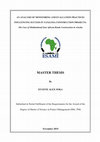Papers by Eng. Eugene A . Soka

Eng. Soka, Eugene, 2019
Road construction projects form a significant part of the entire construction sector that is pote... more Road construction projects form a significant part of the entire construction sector that is potential to the economy of the country. M&E is an essential component of result-based project management with a role to ensure project objectives are effectively realized. Statement of the problem relied on the experience that most of the local construction projects fail to realize their objective due to lack of M&E component in their executions. This study purportedly analyzes the influence of M&E practices in achievement of project success in focus of Tanzanian construction sector, whereby The Multinational East African Roads Construction Project in Arusha was taken as the case study.
M&E Plan and M&E tools and techniques are two predictors to project success that measures extent of achievement of project objectives within the constraints of schedules, budget, scope and technical specifications, despite the interventions by the Government policies. A diversity of literatures and theories from various scholars were reviewed as a building block for this study. Non-random approach, that is purposive sampling involved 24 participants from project teams whereby 22 questionnaires were responded. Collection of primary and secondary data based on multiple approaches through both questionnaires and content analysis by perusal of project archive. Lawshe’s method and Cronbach’s Alpha coefficient achieved instrument’s validity and reliability at 0.99 and 0.7 respectively. Statistical tests including frequency tables, descriptive and inferential statistics were carried out.
The findings were that, adopted M&E Plan and M&E Tools/Techniques had strong positive correlation and altogether attributed to about 39.9% of the project success, despite the negative influence of the intervention by government policies. It was also found that, M&E Plan and M&E tools/techniques had perfect multicollinearity. Attainment of project objectives with project constraints showed positive correlation with Stakeholders satisfaction, as a key indicator for project success.
Either, the study recommends that project teams should improve more on preparations of M&E Plan, appropriate selection of M&E tools and techniques, in order to enhance efficiency and effectiveness with realized objectives in implementation of construction projects in Tanzania. Also, the study suggests further researches to investigate factors that can influence the remaining 60.1% of the required project success.

Eng. Soka, Eugene, 2014
Construction of buildings, both residential and commercial settings, carried in the city of Arush... more Construction of buildings, both residential and commercial settings, carried in the city of Arusha located in northern Tanzania has been an absolute challenge in ensuring the desired qualities are maintained to acceptable aesthetic levels. This is due to attacks by efflorescence to finished surfaces that severely damage structural components including structural concrete, steels and paintings. This study analyzes associated construction materials including sand, pumice and ground water sourced from Njiro soils and ground waters, Oldonyosambu pumice quarries and Mirongoine river sand. The findings revealed presence of various chemical elements that when dissolved in water they react to form bicarbonate compounds, that entail severe destruction to finished surfaces and other parts of a structure. However, the study suggests some precautionary and remedial measures in effort to suppress the problem.











Uploads
Papers by Eng. Eugene A . Soka
M&E Plan and M&E tools and techniques are two predictors to project success that measures extent of achievement of project objectives within the constraints of schedules, budget, scope and technical specifications, despite the interventions by the Government policies. A diversity of literatures and theories from various scholars were reviewed as a building block for this study. Non-random approach, that is purposive sampling involved 24 participants from project teams whereby 22 questionnaires were responded. Collection of primary and secondary data based on multiple approaches through both questionnaires and content analysis by perusal of project archive. Lawshe’s method and Cronbach’s Alpha coefficient achieved instrument’s validity and reliability at 0.99 and 0.7 respectively. Statistical tests including frequency tables, descriptive and inferential statistics were carried out.
The findings were that, adopted M&E Plan and M&E Tools/Techniques had strong positive correlation and altogether attributed to about 39.9% of the project success, despite the negative influence of the intervention by government policies. It was also found that, M&E Plan and M&E tools/techniques had perfect multicollinearity. Attainment of project objectives with project constraints showed positive correlation with Stakeholders satisfaction, as a key indicator for project success.
Either, the study recommends that project teams should improve more on preparations of M&E Plan, appropriate selection of M&E tools and techniques, in order to enhance efficiency and effectiveness with realized objectives in implementation of construction projects in Tanzania. Also, the study suggests further researches to investigate factors that can influence the remaining 60.1% of the required project success.
M&E Plan and M&E tools and techniques are two predictors to project success that measures extent of achievement of project objectives within the constraints of schedules, budget, scope and technical specifications, despite the interventions by the Government policies. A diversity of literatures and theories from various scholars were reviewed as a building block for this study. Non-random approach, that is purposive sampling involved 24 participants from project teams whereby 22 questionnaires were responded. Collection of primary and secondary data based on multiple approaches through both questionnaires and content analysis by perusal of project archive. Lawshe’s method and Cronbach’s Alpha coefficient achieved instrument’s validity and reliability at 0.99 and 0.7 respectively. Statistical tests including frequency tables, descriptive and inferential statistics were carried out.
The findings were that, adopted M&E Plan and M&E Tools/Techniques had strong positive correlation and altogether attributed to about 39.9% of the project success, despite the negative influence of the intervention by government policies. It was also found that, M&E Plan and M&E tools/techniques had perfect multicollinearity. Attainment of project objectives with project constraints showed positive correlation with Stakeholders satisfaction, as a key indicator for project success.
Either, the study recommends that project teams should improve more on preparations of M&E Plan, appropriate selection of M&E tools and techniques, in order to enhance efficiency and effectiveness with realized objectives in implementation of construction projects in Tanzania. Also, the study suggests further researches to investigate factors that can influence the remaining 60.1% of the required project success.